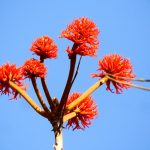
TREE LIFE 542
OCTOBER 2025
PLANNED EVENTS:- OCTOBER 2025
Since inclement weather or other issues may vary our plans, WhatsApp Tony Alegria on 0772 438 697 to join our WhatsApp group for last minute updates.
Saturday 4th October 2025:- visit to the National Botanic Gardens. Meet at 8.30 in the main car park and join us for a morning looking at trees that catch our interest.
October 2025:- The Main Outing – Visit to the Forestry Commission Headquarters on Sunday, October 19th
We have obtained permission to visit the Forestry Commission HQ on Sunday October 19th. There is a great range of interesting native and exotic trees, some of which are very rarely seen in Zimbabwe. Among the treats in store is an enormous Agathis australis (the Giant Kauri), Cunninghamia lanceolata (Chinese fir) and a real novelty, Bursera bipinnata (Copal tree) from the same family as our commiphoras with a mixture of simple and two-pinnate leaves.
Directions: Starting from the city centre, take the ED Mnangagwa (Enterprise) Road, proceed straight across the Newlands Roundabout and continue on ED Mnangagwa Road for 1.1 kms and then turn left into Orange Grove Drive. Travel 300 m and on the left is the entrance to the Forestry Commission where there a boom gate. The staff at the gate should be expecting our visit. Once through the gate there are two turnings immediately to the left; ignore the first one and take the second one (there is a sign saying Head Office – Visitors’ Carpark). We will meet in the carpark at 9:30 am.
The venue, time and date for this outing has not yet been confirmed. Notice will be posted by email and on the WhatsApp group. It is probable that it will be the third weekend in October (18th or 19th) so check your calendar now.
You do not have to be a member to join us for most of our activities. You may decide to become a member and join us for all of activities.
REPORTS FROM PREVIOUS OUTINGS
Saturday 6th September 2025 :- National Botanic Garden Outing
By Tony Alegria, photo by Jim Dryburgh
It was a bright sunny day but only six of us were present: Dawn Siemers, Dido de Swardt, Charles Crawshaw, Jan van Bel, Jim Dryburgh and myself. Jan and I had decided to revisit the Asian Section to see if any trees were in flower to help us identify more of these exotic trees for the tree labelling exercise whose list now numbers 520 species of trees.
We set off from the car park on what is a long walk for the tree society – to walk beyond the Herbarium to the Asian Section! En route we looked at just a few species of tree – the first were the two completely leafless. Xeroderris stuhlmannii, Wingpod which are close to the car park, the second was the Tamarindus indica which was a bit further on. But even a bit further was a totally leafless fig tree absolutely laden with ripening warty figs. This was a Ficus bussei. Zambezi fig and if you are hungry, these figs taste pretty good! Some of us did sample these figs after opening them up to make sure there weren’t too many nasties inside.
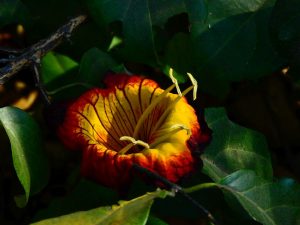
Fernandoa abbreviata
For comparison we looked at a Ficus sansibarica. Knobbly fig to the east of the Herbarium. Only one of the three fig trees had a few fruit. Whilst the figs of the Zambezi fig grow at the ends of the branches, the figs of the Ficus sansibarica, as the common name suggests, grow on knobs on old wood almost down to ground level.
To the north and fairly close to the herbarium are a few Fernandoa abbreviata mislabelled as Fernandoa magnifica. These trees are from Malawi and are also grown in private gardens.
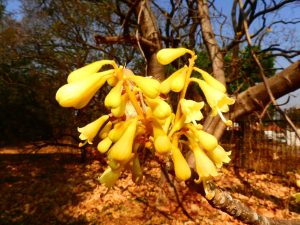
Firmiana colorata
The Asian section is not very large but in the early seventies, it had 209 trees according to the list for that section which doesn’t appear to have been updated since then. Most of the trees there were leafless which didn’t help us identify any new trees at all. The completely leafless Firmiana colorata, known as the Chinese parasol tree was in full bloom with clusters of small tubular yellow flowers – this tree looks very much like a Sterculia.
There were two trees with fruit: the Morinda lucida with strange looking knobbly compound fruit with a hole at the end of each knob where the flower had fallen off and the other is a tree unknown to us which had small drupes – the ripe ones were a dull yellow.
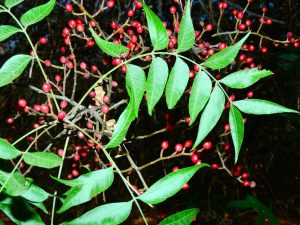
Pistacia chinensis
Next to a Ficus microcarpa. Chinese banyan or Indian laurel were a couple of rather domed looking trees with very interesting sickle-shaped leaves and small berries – Pistacia chinensis. Chinese pistache which is in the cashew family Anacardiaceae and is native to central and western China. It’s the Pistacia vera that gives us those green looking pistachio nuts.
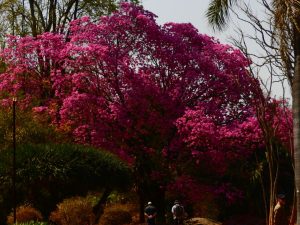
Hydroanthus heptaphyllus near the
herbarium (see editors note)
On the way back to the car park we were amazed by the pink tabebuia next to the Herbarium, Tabebuia heptaphylla which now has a new name Handroanthus heptaphyllus. It was in full bloom and absolutely stunning. It was noted that the odd branch had no flowers, just leaves.
Editor’s note thanks to AI:
A 2007 DNA study showed that the members of genus Tabebuia were not all descendants of a common ancestor and about 30 Tabebuia species were renamed Handroanthus. Tabebuia and Handroanthus both belong to Bignoniaceae, a family of deciduous, evergreen, and semi – evergreen trees, bushes, and vines known for its showy flowers which includes Jacarandas, Spathodeas, Cape honeysuckle, and cat’s claw creeper.
Handroanthus can be distinguished from true Tabebuia by the minute hairs on the leaves or flowers and extremely dense wood. Tabebuia is restricted to those species with white to red or rarely yellow flowers.
However, when asked to identify the pictures taken by Jim, Mark Hyde identified the above picture of the pink tree near the herbarium as Handroanthus impetiginosus not H. heptaphyllus.
What to do as an editor?
I turned to GOOGLE and I find that both of these, together with other species of Handroanthus, are known as the pink trumpet tree and while both produce pink to purple flowers they are sometimes misidentified as each other. So I challenged Mark.
He referred me to the distinction between the two lies in the leaf margins and produced the following extract from the key in Gentry, A.H. (1992). Bignoniaceae – Part II (Tribe Tecomeae). Flora Neotropica and pictures for me:
Key:
5 Leaflets of mature leaves regularly serrate; petiolules relatively long and slender, the terminal petiolule about as along as leaflet width, the basal petiolules more than half as long as the adjacent subbasal petiolules; fruit valves thin, often longitudinally striate, the fruit mostly less than 1.5 cm wide ……………………………………………………………………. heptaphyllus.
6 Leaflets of mature leaves entire or slightly and irregularly serrate towards apex; terminal petiolule shorter than width of the leaflet; basal petiolules less than half as along as adjacent subbasal petiolules; fruit woody, usually smooth, mostly greater than 1.5 cm wide ……………………. impetiginosus
Alwyn H. Gentry was an American botanist who specialised in tropical forests and was an expert in the Bignoniaceae.
So H. heptaphylla has serrated leaf edges while
H. impetiginosus has entire leaf margins
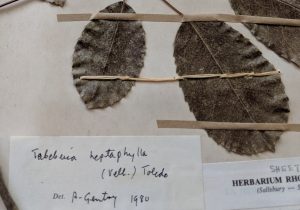
Tabebuia heptaphylla
(now known as H. heptaphyllus) specimen
from the Zimbabwe National Herbarium
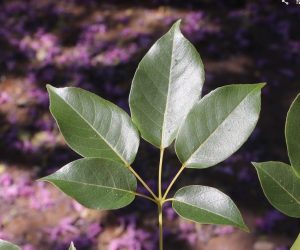
A photo of a leaf from the tree next to
the herbarium identified by Mark
Hyde as H impetiginosus
I encourage members to visit the National Botanical Gardens and see the tree for themselves.
September 2025:- Main outing
The second tree outing in September was cancelled as there was a Tree Society Adventure to Smallbridge Dam, Mountain Home (the home of John and Barbara Meikle’s established in the late 19th century), Nyamakwarara school and Gurunguwe Mountain, La Rochelle Estate, The John Meikle Forest Research Station. The reports on these visits will follow in the next issue of Tree Life but below are a few pictures taken by members of the group.
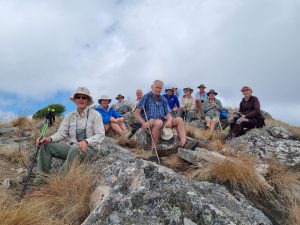
At the summit of Mount Gurunguwe
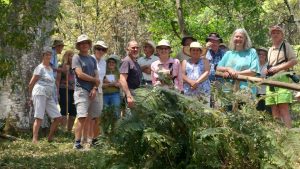
Among the big gums at
Mountain Home Farm
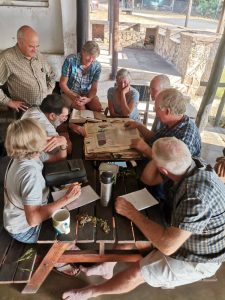
Pressing and identifying
specimens collected
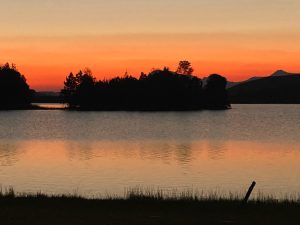
Sunset at Smallbridge Dam
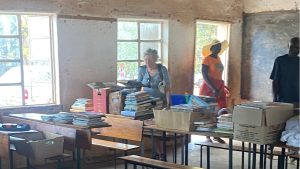
Books for the library and school supplies
for Nyamakwarara School
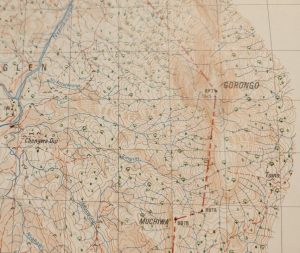
1:50,000 map showing Mount Guruguwe and the Nyamakwarara river
FROM THE WALRUS TO THE CARPENTER
MOUNT GORONGO
With thanks to Rob Jarvis
Looking for Gurunguwe Mountain on the 1:50,000 map I was puzzled. I know we have had name changes but was this the same place? Rob explained
“Yes it is, Gurunguwe is the English name and Gorongo the local name, it means the sound that the mountain makes when bits fall off it”, and looking at the range of mountains, beyond, this must have happened often to form the dragons tail.
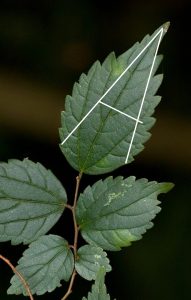
Celtis africana
KARLS DONKEY BRAIN IDENTIFICATION
By Linda Hyde
I was intrigued when Karl told me that he distinguished between Celtis africana and Trema orientale using his donkey brain. I thought “ the leaves are alternate and spear shaped for both so what?”
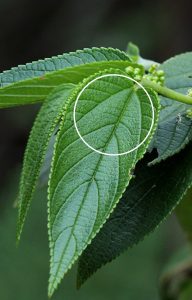
Trema orientale
He explained that the leaf structure showed him the A and O for each. Further explanation was needed for my pea brain, “It is in the leaf margins” he said.
Look carefully and you will see:
-
-
-
-
-
- the toothed margin of Celtis africana is open at the base, A;
-
-
-
-
while
-
-
-
-
-
- the toothed margin of the Trema orientale extend to the base in an O:
-
-
-
-
Thank you Karl.
A TRIP TO SAVE VALLEY AND GONAREZHOU NATIONAL PARK
By Ian Riddell
Over 6-10 June, I joined Karl Van Laeren on a short trip to Gonarezhou National Park, via the Save Valley Conservancy, our main focus being the birds and trees, and anything else, of course. This article will focus on plants. Records were uploaded to iNaturalist and links are at the end of this article for those interested in more photos and localities.
6th June, Save Valley Conservancy
Our first night was spent on Humani Ranch and it was dark by the time we reached the Turgwe River, dark flowing water, reedbeds and tall riverine trees illuminated by the headlights as we crossed the rock-lined causeway. This looked like a wonderful area to explore but not on this trip. Actually, the society did an expedition here in 2016, see Tree Life 434, 435 & 436. Fortunately, Karl knew what roads to follow but the track seemed long and narrow, hemmed in by thick bush rushing by in the headlights. Our campsite turnoff didn’t look right, the sign a little overgrown and the turnoff itself blocked with growth, but this was a trick of light, the headlights making the herbs growing there look much thicker than they actually were, as we discovered the next morning. We took the track, navigating around a fallen tree to arrive at a cleared patch under some Fever Berry Crotons Croton megalobotrys. In the dark we wondered if this was the right place as there seemed to be nothing there!
The first night in a new bed (mattress in a tent in this case) is often unsettled and I was awake most of the night. At 1.30 a.m. some nearby Helmeted Guineafowls set up a chatter, probably disturbed by some predator, and through the night I enjoyed the calls of leopard, hyaena and some lions, the latter getting closer and closer to our camp as dawn approached.
7th June, Save Valley to south Gonarezhou
The Southern Ground-hornbills announced a new day at 4.52 a.m., with our neighbouring lion still going at it and answered by another further to the west, and Fiery-necked Nightjars started calling. The bush came alive with the dawn chorus and I joined Karl down the river bank for morning coffee, realising we were actually further down the now widened Turgwe, the river flowing down braided channels.
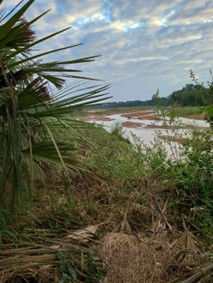
and downstream
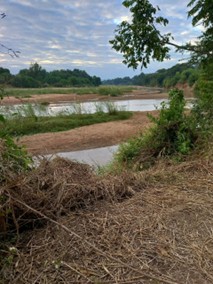
The Turgwe, looking upstream…
Six Southern Ground-hornbills were on the sand and a whole host of Helmeted Guineafowls rushed to and fro with too much early morning energy. Somehow the photos of various herbs and creepers at our viewing spot weren’t on the camera card when I downloaded it – a pity as some were familiar and others interesting – but an Ilala Palm Hyphaene petersiana was also growing there as well as Trichilia emetica.
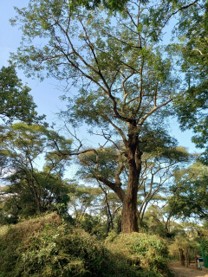
Poison-pod Albizia
with acacia woodland behind
We had a long way to go so packed up camp, but not before noticing a boma with a long-drop (and was there a water tank?) as we drove out, all festooned with a blanket of drying creepers – the area had had a good rainy season! We decided to quickly check out the other two campsites further down river, continuing along the main track through acacia country that bordered the riverine. These were more established than our wild little corner of paradise, under big riverine trees like Wild Mango Cordyla africana, and next to the ablution block was a huge Poison-pod Albizia Albizia versicolor. I had never seen such big specimens and didn’t really recognise it.
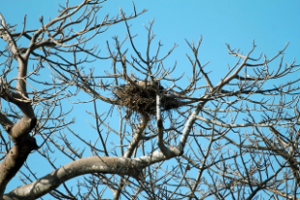
White-backed Vulture in a baobab
Returning to Humani headquarters we passed a Baobab Adansonia digitata with a nesting White-backed Vulture huddled low on its nest – not much of a view but a nice bird to see nonetheless.
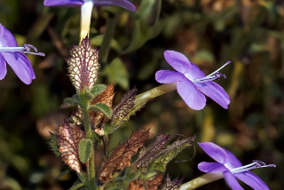
Barleria spinulosa
I had never been south of Sango Ranch so it was nice to travel new countryside to the Chiredzi road, finding an African Fish-eagle on a dam where we stopped to photograph Barleria spinulosa bushes on the dam wall. My old 1: 250,000 map calls this Chigwete Ranch but it may actually be part of Humani.
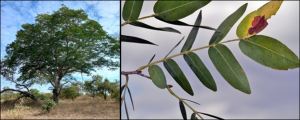
Brachystegia torrei on Senuko Ranch
On Senuko we stopped to investigate an area of “Mountain Acacias” growing on flat sands (-20.66204, 32.00282). This exciting find was of Brachystegia torrei and the leaves picked had only 4-5 pairs of leaflets on this tree although they typically should have 6-10 pairs. Brachystegia torrei was separated from Brachystegia tamarindoides torrei, a sensible split. We were to find more in Gonarezhou in the afternoon.
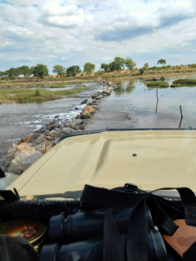
Crossing the Runde at Chipinda Pools
We checked in at the Malilangwe gate, having to first change a deflating tyre, and after getting it repaired at Chipinda Pools we crossed the Runde in the early afternoon.
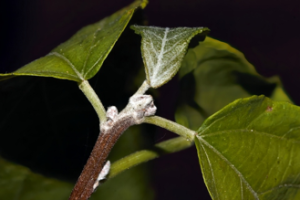
Acalypha pubiflora
We went down the east side of Nyamarongwe Hill (don’t try this without a 4×4 with low-range, there is lot of deep, loose sand to climb through!) and found a Limpopo false-nettle Acalypha pubiflora on the roadside and then more a bit further on at a stream crossing.
This took a bit of puzzling to identify and I thought it was very Croton-looking but with long leaves and striking white fluff-covered buds in the leaf axils. There is quite a lot of it along the Runde floodplain, too.
Heading southwest on the higher plateau of cretaceous sands we stopped to age and measure some old elephant bones that Karl knew about. Growing in this different habitat was Rams Horns Hugonia orientalis, a favourite of mine, though this one didn’t have many paired twirly horns.
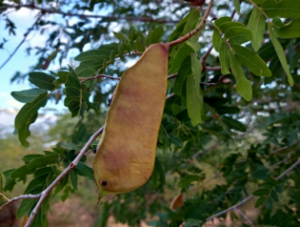
Brachystegia torrei
hen onwards until we drove into a patch of Torre’s Brachystegia Brachystegia torrei trees on the red sands (-21.63394, 31.81960). These had 4-7 pairs of leaflets, but mostly just 4. This was another great find as Anthony Cizek, who had done 2 months of vegetation sampling in the north of the park, had told me he had many locations but that there were few of tree-size left because of elephants and it occurs as an impacted shrub. Odd trees remain in the western parts of the Chionja Platform some way from roads. The ‘gorges’ of the Runde upstream of Chinguli, where the sides are steeper and rocky, are also good place.
Farrell (1968) in Kirkia 6(2) mapped this as Brachystegia glaucescens.
We also found Two-winged Pteleopsis Pteleopsis myrtifolia growing on these sands and once we had ‘got our eyes in’ we recognised many along the road on our way back on the 10th.
With a way to go we didn’t dally through the Guluweni upper drainage, but I noticed many Eared Sennas Senna petersiana on the long straight to Gorwe Pan (the one without a platform), where we took a track to Gorwe Platform Pan, arriving at dusk.
8th June, Gorwe pans
Gorwe (or Gorhwe) still had a lot of water but no platform – just a long-standing ¾ ring of poles. The platform was still to be built and, in fact, on our way out on the 11th, whilst getting 2 punctures repaired, we saw the truck at Chipinda Pools laden with long gum poles ready to set out. By now the platform and a long-drop would be completed and visitors to the south of the park might like to consider this as a place to stay!
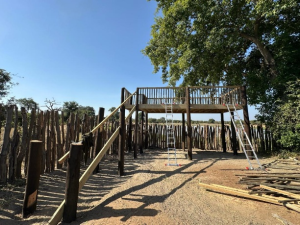
new platform under construction (© Andy Wilkinson)
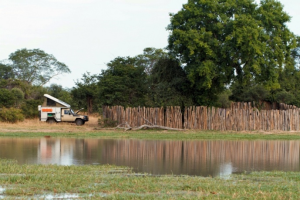
Gorwe Platform pan without platform © Ian Riddell and ……
Baboons and a thundering and snorting herd of zebras at 2.20 a.m. were concerned about 2 male lions – they walked by my tent in silence, as evidenced by the spoor we found the next day!
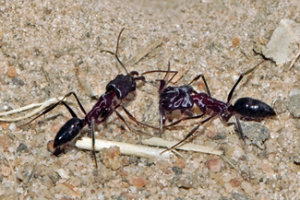
Troglodyte Trap-jaw Ants Odontomachus
troglodytes
We circled the pan in the morning, looking at trees, birds and more lion spoor. A most fascinating discovery were some Troglodyte Trap-jaw Ants Odontomachus troglodytes. Karl’s book describes them as having “long, straight mandibles that can lock open at 180°. Sensory hairs inside the mandibles act as triggers for the jaws that can snap shut at incredible speed. These jaws are thought to be the fastest predatory appendages in the animal kingdom, snapping shut at speeds of up to 230 km/h, with a peak force some 300 times the weight of the ant.” The ants were conveniently crawling over the herb Bachelor’s Button Gomphrena celosioides.
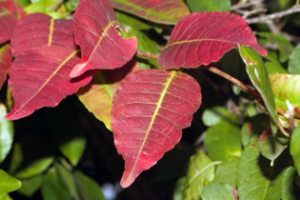
Tamboti leaves
Surrounding the pan, we looked at African Ebony Diospyros mespiliformis with the trunk polished by elephant rubbing, Shepherd’s Tree Boscia angustifolia, Tamboti Spirostachys africana with leaves turning a striking red and Mouse-eared Combretum Combretum hereroense with quite large leaves. A termite mound on the edge had Water Iron-plum Drypetes mossambicensis and Lowveld Milkberry Manilkara mochisia growing together and a number of Bird Plums Berchemia discolor.
Amongst the herbs were Bergia sp. with purplish flowers and Selago sp. Scrophulariaceae, with small white flowers. The Melhania with grey-green furry leaves was perhaps Melhania rehmannii.
A number of Pink-fruit Canthium Canthium glaucum frangula grew on the edge of the bush and one was unusual with some branches with 3 spines rather than opposite pairs. Eared Sennas Senna petersiana were scattered about.
Back at camp were Variable Combretums Combretum collinum, Small False Mopane Guibourtia conjugata. I sat in the shade of a well-browsed tree/bush that I eventually identified as Small-leaved Bloodwood Pterocarpus lucens antunesii (we later saw quite a few of these in the area) photographing leaves from yesterday and the comings and goings to the many Boot Protector Dicerocaryum senecioides creeper flowers.
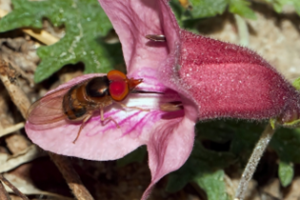
Rhingia sp
They were popular with a Ceroctis blister-beetle, a rather fancy looking Rhingia snouted hoverfly and lots of butterflies. A Sleepy Morning Waltheria indica herb provided an ideal sally point for a Red Basker dragonfly over the pink carpet of flowers.
In the boma area a Raphiophora intricata plant hopper has its piercing mouthparts sunk into the central vein of a Strychnos potatorum leaf, Strychnos being a main food plant of this genus. Just outside the boma was a Spiny Monkey-orange Strychnos spinosa.
On our afternoon drive we stopped at some elephant bones. Karl estimated her age at near 70 years, very old for an elephant, and the bones showed a lot of arthritis with the sacrum fused to the pelvis and a lot of the spinal processes fused, too. Poor old girl.
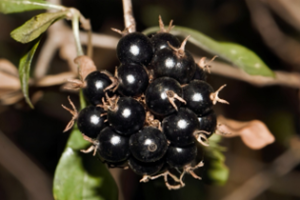
Pavetta gracillima in fruit
Along another track we stopped at another small pan and whilst Karl did a circuit I was stopped, fascinated by a fruiting Pavetta gracillima at the vehicle. This was a great find as it occurs in the southeast lowveld and adjacent Mozambique as a near-endemic and the only record on the Flora of Zimbabwe site is from the Mahenya forest on the other side of the Sabi-Runde confluence, and the only iNaturalist records are south of the Save River near the coast.
Mark thought it looked good for gracillima and the Field Research Technician at Chipinda, Julius Shimbani, thought so too.
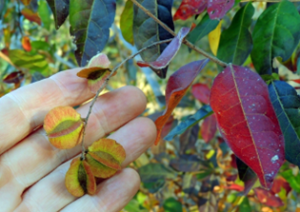
Combretum patelliforme in autumn leaf
colours
We ran out of track a little further on and turned around at another pan, but stopped at a colourful Combretum, the leaves in various shades of red to plum. This was another interesting find that led to much discussion.
Was it Combretum celastroides or padoides?
The former is well-known for these leaf colours and Combretum celastroides orientale, the subspecies in the lowveld, is said to resemble padoides, but “the latter has a different habit, often with long trailing branches scrambling into adjacent trees, the fruits smaller with the apical peg very short to absent”, according to Coates Palgrave.
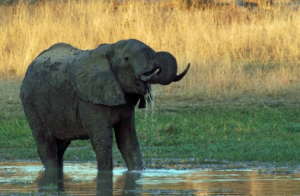 Our bush wasn’t scrambling and the fruits had distinct apical pegs; I also thought the petioles were shorter and thicker than padoides. Julius later confirmed that there was a lot of Combretum celastroides in the Gorwe area. But we aren’t quite finished! Taxonomic changes have moved orientale to the Limpopo jessebush Combretum patelliforme, which in Zimbabwe is restricted to the southeast lowveld… another new and interesting species!
Our bush wasn’t scrambling and the fruits had distinct apical pegs; I also thought the petioles were shorter and thicker than padoides. Julius later confirmed that there was a lot of Combretum celastroides in the Gorwe area. But we aren’t quite finished! Taxonomic changes have moved orientale to the Limpopo jessebush Combretum patelliforme, which in Zimbabwe is restricted to the southeast lowveld… another new and interesting species!
We did a quick evening run to Lion Pan, where we saw our only elephant in the south of the park. Not that they were few and far between, tracks were all over the place but so was water.

Datura discolor
9th June, Gorwe pans
On the edge of the camp was a clump of Desert Thorn-apple Datura discolor growing amongst the branches of a fallen tree.
There are a number of iNaturalist records from Tuli, down the Limpopo and up through Gonarezhou to the Save-Runde confluence.
Next to this was a Showy Plane Ochna natalitia (with characteristic galls) at the base of a tree and a big Hugonia orientalis full of fruit with a lot uneaten on the ground, and we did wonder what animal or bird actually ate these to spread them around.
We circled the pan and I photographed the Buffalo Grass Stenotaphrum secundatum and Creeping Ludwigia Ludwigia adscendens that were the main water plants. There was some Duckweed Lemna aequinoctialis growing amongst them. Wandering into the open bush we noticed a Sjambok Pod Cassia abbreviata.
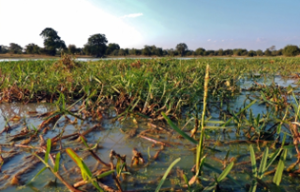
Pan habitat with flowering Buffalo Grass
In the afternoon I went searching for the hidden frogs that called but frustratingly didn’t reveal themselves in the Buffalo Grass and Ludwigia (later identified as Red-legged Kassina), heading to a big 3-trunked Diospyros mespiliformis at the edge of the pan. From the elevated viewpoint where the trunks met, the sharp quoip calls was all I was going to get, but high up one trunk I spotted an epiphytic Knobby Fig Ficus sansibarica.
Back on the pan edge I photographed some buffalo grass inflorescences and a rather dry looking Y-thorned Torchwood Balanites maughamii on the edge of the bush that had more straight thorns than forked ones, but I don’t think it was Balanites pedicellaris.
I picked up the unmistakeable distant and bellows of buffalo and a cloud of dust rising over the bush so headed back. We hid behind the boma poles so as not to spook them and gradually the dust, bellows and lowing came closer and Yellow-billed Oxpeckers landed in the trees. What a treat it was when the herd some 180 emerged to drink in the evening light to the calls of frogs and the careful probing of African Jacanas in the water in front of us.
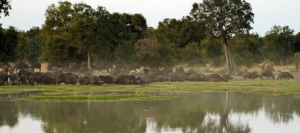
In the morning I had remarked to Karl that it was odd that the wind had switched around to a westerly. We enjoyed dinner with beautiful cloud patterns depicting mythological beasts transforming under an almost full moon as the west grew darker. More ominous was a distant rumble, was it a train from Mozambique? A black cloud rapidly loomed closer, lit with flashes of lightening and booming thunder, and I retreated to my tent to prevent it from taking wing in the tempestuous dark as rivulets of water seeped in (I need a new tent). A dramatic last night in the south, but the lowveld can throw unprecedented weather at you, even in June.
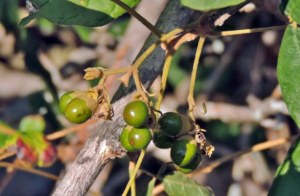
Plum Finger-leaf Vitex ferruginea in fruit
10th June, Gorwe to the Runde River
We had an early start the next morning with a long drive back to Chipinda Pools. We stopped off at the elephant bones again and noted a big bushy Plum Finger-leaf Vitex ferruginea in fruit.
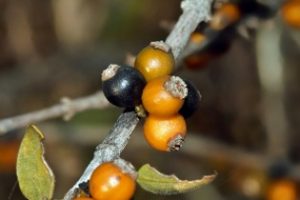
Dwarf Butterspoon Coptosperma zygoon
A bush with orange fruit, some ripe ones black, was a Rubiaceae but had us stumped. I think it was Julius who identified it as Dwarf Butterspoon Coptosperma zygoon; it turned out to be quite common in the area.
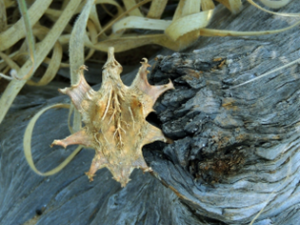
Harpagophytum zeyheri sublobatum with
a claw in a Lebombo Ironwood log
There were a few more big Combretum patelliforme here and I thought I had better photograph the Lebombo ironwood Androstachys johnsonii since they were a feature of the park with lots of dense bushy stands hereabouts. Besides, the white woolly growing tips and undersides of the leaves are just so beautiful.
There were lots of Devil’s Claw Harpagophytum zeyheri sublobatum here and at other stops due to the good rains this season and there was still lots of good grazing for buffalo in the area.
We headed to Corner Pan and through lovely woodland close to the Mozambique border with Combretum imberbe and Creeping Bauhinia Tylosema fassoglense clumps everywhere.
Heading northwest off the high ground down into Mopane Colophospermum mopane country we braked sharply for an Olive Grass Snake. Fortunately, it didn’t get run over and whilst photographing it I recognised Elytraria acaulis in the scrub, but was stumped with another herb.
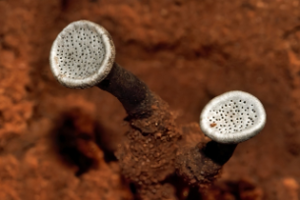
Poronia sp., perhaps punctata
Heading towards the Mulowe River we stopped to look at some trees and Karl noticed some delightful Poronia fungi in deep sand of the middle-mannetjie. Although we dug into the sand, we didn’t go deep enough to find what it was growing from. Cathy Sharp said they grow up from dung or wood or other organic matter.
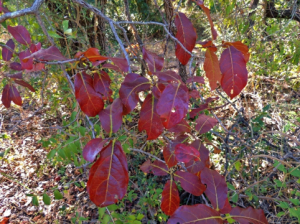
Diospyros loureirian
At the river I took the opportunity to photograph a Sand Star-apple Diospyros loureiriana. We had driven past many of these in the north of the park, their deep red leaves particularly striking, and later saw many more along the Runde floodplain. Karl had pointed one out on Humani Ranch but those didn’t have the autumnal colours yet.
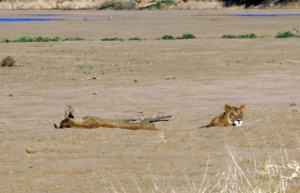
We were going to camp at Chipinda for the night but at Fishans crossing, where a couple of lionesses were lolling about on the riverbed, Karl decided to enjoy some luxury and decided to stay at the new (for me) Chipali Camp on the banks of the Runde.
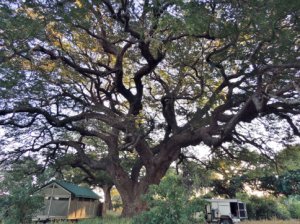
Wild Mango Cordyla africana shading
self-catering tents
Here there are self-catering luxury tents set under magnificent Wild Mango Cordyla africana trees. The one at out tent had a 7 m circumstance at breast height and a 50 m canopy diameter. The camp had a few electrified high wires to keep elephants out, whilst allowing smaller animals underneath.
A Hyaena and Black-backed Jackal choir performed a delightfully eldritch dithyrambic finale for our last night in the park.
Online records
Acalypha pubiflora https://www.inaturalist.org/observations/289507173
Albizia versicolor https://www.inaturalist.org/observations/288991464
Androstachys johnsonii https://www.inaturalist.org/observations/294021711
Androstachys johnsonii https://www.inaturalist.org/observations/294028726
Balanites maughamii https://www.inaturalist.org/observations/293065365
Barleria spinulosa https://www.inaturalist.org/observations/289471993
Bergia https://www.inaturalist.org/observations/291138822
Boscia angustifolia https://www.inaturalist.org/observations/290388899
Brachystegia torrei https://www.inaturalist.org/observations/289211523
Brachystegia torrei https://www.inaturalist.org/observations/290123461
Canthium glaucum frangula https://www.inaturalist.org/observations/291415083
Canthium glaucum frangula https://www.inaturalist.org/observations/291415908
Cassia abbreviata https://www.inaturalist.org/observations/292807742
Combretum collinum https://www.inaturalist.org/observations/290627988
Combretum hereroense https://www.inaturalist.org/observations/290618294
Combretum patelliforme https://www.inaturalist.org/observations/292132206
Combretum patelliforme https://www.inaturalist.org/observations/294003819
Coptosperma zygoon https://www.inaturalist.org/observations/293993427
Coptosperma zygoon https://www.inaturalist.org/observations/294033775
Cordyla africana https://www.inaturalist.org/observations/294786258
Datura discolor https://www.inaturalist.org/observations/292344103
Dicerocaryum senecioides https://www.inaturalist.org/observations/290396983
Dicerocaryum senecioides https://www.inaturalist.org/observations/291718434
Diospyros loureiriana https://www.inaturalist.org/observations/294541380
Diospyros mespiliformis https://www.inaturalist.org/observations/290621226
Drypetes mossambicensis https://www.inaturalist.org/observations/291156391
Elytraria acaulis https://www.inaturalist.org/observations/294276921
Ficus sansibarica https://www.inaturalist.org/observations/293072983
Gomphrena celosioides https://www.inaturalist.org/observations/291404056
Guibourtia conjugata https://www.inaturalist.org/observations/290907926
Harpagophytum zeyheri sublobatum https://www.inaturalist.org/observations/291706987
Harpagophytum zeyheri sublobatum https://www.inaturalist.org/observations/294023758
Hugonia orientalis https://www.inaturalist.org/observations/289465759
Hugonia orientalis https://www.inaturalist.org/observations/292338752
Hyphaena petersiana https://www.inaturalist.org/observations/288985692
Lemna aequinoctialis https://www.inaturalist.org/observations/292814345
Ludwigia adscendens https://www.inaturalist.org/observations/292825013
Manilkara mochisia https://www.inaturalist.org/observations/291141694
Melhania https://www.inaturalist.org/observations/291164762
Ochna https://www.inaturalist.org/observations/292591100
Pavetta gracillima https://www.inaturalist.org/observations/292070439
Phyllogeiton discolor https://www.inaturalist.org/observations/290655782
Phyllogeiton discolor https://www.inaturalist.org/observations/292810625
Poronia https://www.inaturalist.org/observations/294537723
Pterocarpus lucens antunesii https://www.inaturalist.org/observations/291547519
Selago https://www.inaturalist.org/observations/291147841
Senna petersiana https://www.inaturalist.org/observations/290872882
Spirostachys africana https://www.inaturalist.org/observations/290466749
Stenotaphrum secundatum https://www.inaturalist.org/observations/292625487
Stenotaphrum secundatum https://www.inaturalist.org/observations/292889208
Strychnos spinosa https://www.inaturalist.org/observations/292045400
Terminalia myrtifolia https://www.inaturalist.org/observations/289767259
Tylosema fassoglense https://www.inaturalist.org/observations/288961756
Unidentified herb https://www.inaturalist.org/observations/294537119
Vitex ferruginea https://www.inaturalist.org/observations/293981141
Waltheria indica https://www.inaturalist.org/observations/291425464
TREE SOCIETY TREE LABELLING GROUP
This group, which is led by Tony Alegria with the active support of Mark Hyde and Jan van Bel, as well as the participation of other interested members, meets most weeks at a venue in Harare to promote the labelling of trees in areas open to the public. In many cases the reason is to label trees and produce a unique list of trees that pertains to that site and can be sold at the entrance gate. Often trees are mislabelled or labelled unknown and relabelled after “homework” is completed or they are seen later in the year in flower. All members are welcome to join this small group and have more fun with trees, just contact Tony, Mark or Jan on the contact details below.
TREE SOCIETY COMMITTEE AND CONTACTS
Chairman Tony Alegria tonyalegria47@gmail.com 0772 438 697
Vice Chairman Mark Hyde mahyde@gmail.com 0772 233 751
Honorary Treasurer Bill Clarke wrc@mweb.co.zw 0772 252 720
Secretary Teig Howson teig.howson@gmail.com 0772 256 364
Venue Organiser Ann Sinclair jimandannsincs@zol.co.zw 0772 433 125
Committee Member Jan van Bel jan_vanbel@yahoo.com 0772 440 287
Committee Member Sibusiso Malunga busimalunga@yahoo.com 0775 889 898
Tree Life Editor Linda Hyde Lmharwin@pentact.co.zw 0772 232 075
Tree Society Website https://treesociety.org.zw/
Tree Society Facebook https://www.facebook.com/groups/ztreesociety/
Flora of Zimbabwe: https://www.zimbabweflora.co.zw/
Flora of Tropical Africa: https://plants.jstor.org/collection/FLOTA

